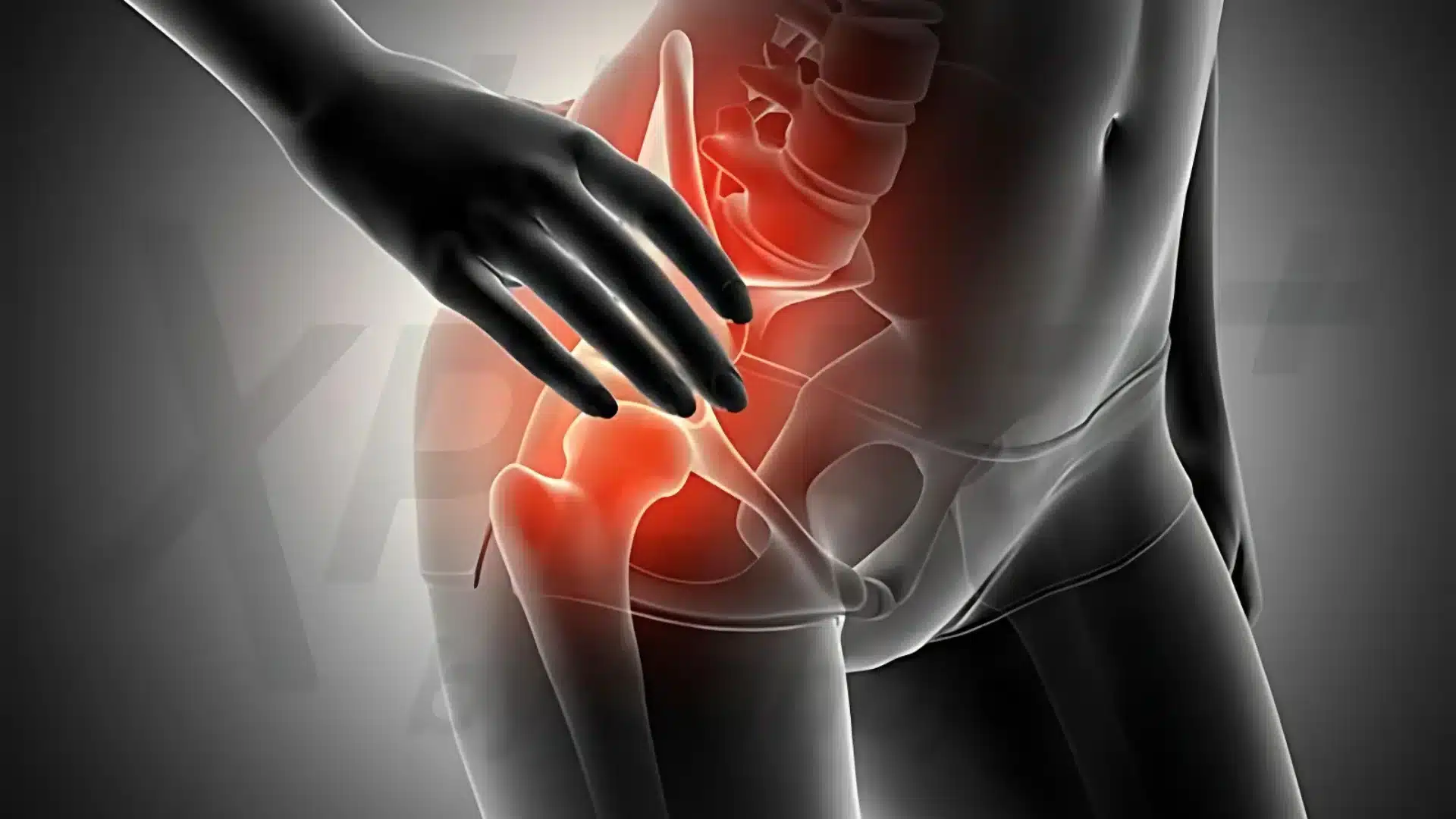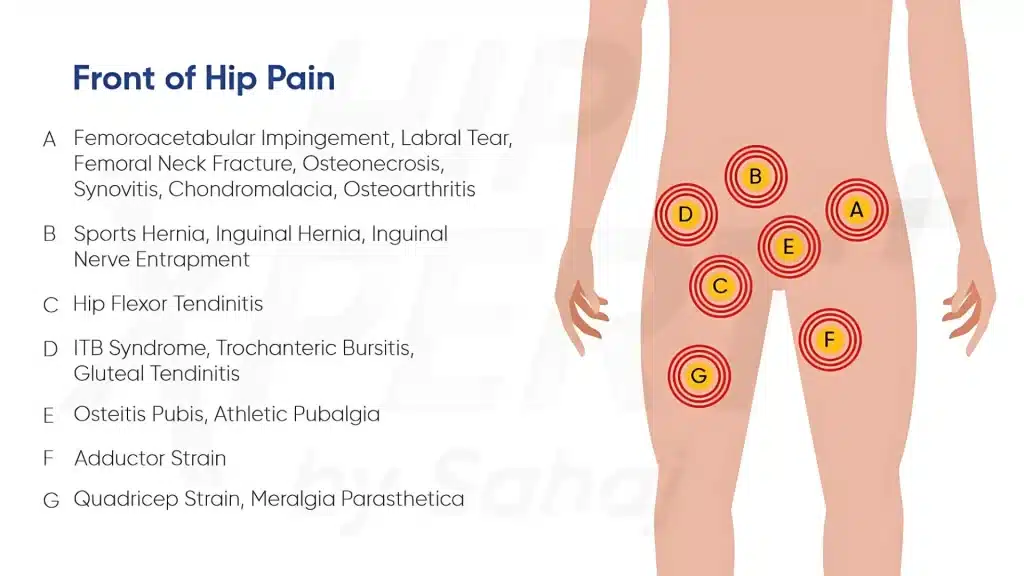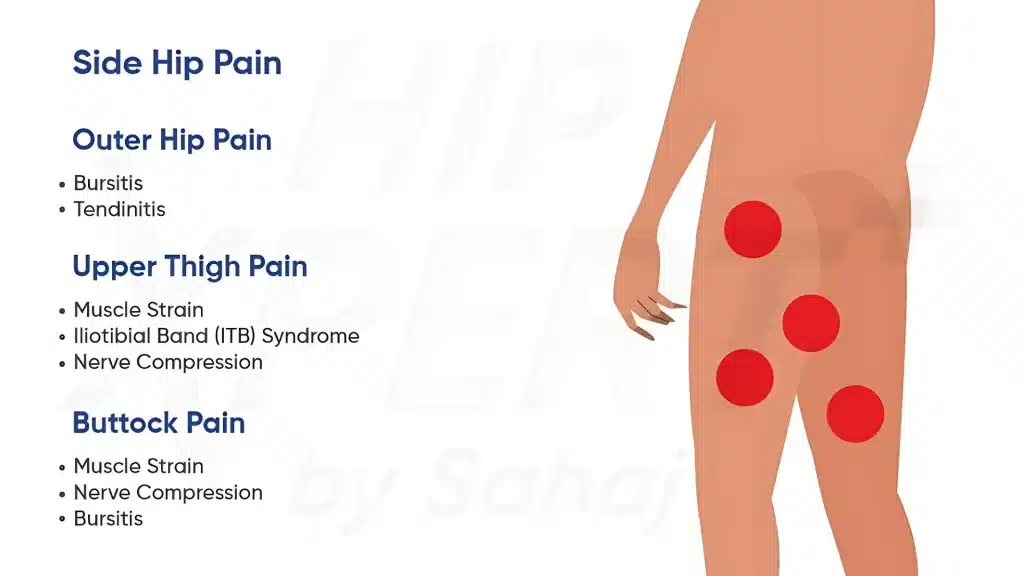Hip Pain Location Diagram: Where Does it Hurt?

Overview
As we previously discussed hip pain, understanding the potential causes of pain in different locations is important. Therefore, we have created a visual guide for hip pain.
Pain in the hip is a difficult experience, and finding out the causes of hip pain is very important for treatment. In this detailed article, we will cover the cause of hip pain at three locations: Front, Back, and Side.
Front Hip Pain
Think of your hip as a ball and socket joint, like a marble resting in a cup. When something’s off in this delicate balance, you might experience pain in the front of your hip. Hip pain can arise from various conditions affecting the bones, joints, muscles, tendons, or nerves around the hip area.
Understanding the type and origin of the pain is critical for effective treatment. Pain is located at the front of the hip or groin area. This type of pain is often linked to conditions affecting the hip joint, tendons, ligaments, nerves, or muscles in the anterior region. Diagnosing the root cause is crucial for effective treatment.

Causes of Frontal Hip Pain
1. Hip Joint Conditions
Femoroacetabular Impingement (FAI): Also called hip impingement, abnormal contact between the femoral head and acetabulum, leading to joint damage. Symptoms include groin pain and limited range of motion.
Labral Tear: A tear in the cartilage surrounding the hip socket, often due to repetitive stress or trauma, causing groin pain, clicking, or locking sensations.
Femoral Neck Fracture: A break in the femur’s neck, common in older people with osteoporosis, causing acute hip pain and difficulty bearing weight.
Osteonecrosis: Also called AVN, it is death of bone tissue in the femoral head due to lack of blood supply, causing deep groin pain and reduced mobility.
Synovitis: Inflammation of the synovium (lining of the hip joint), often caused by overuse or arthritis, resulting in hip pain and swelling.
Chondromalacia: Softening or degeneration of cartilage in the hip joint, causing pain and stiffness during movement.
2. Groin and Inguinal Conditions
Sports Hernia (Athletic Pubalgia): A soft tissue injury in the groin area, not a true hernia, common in athletes, causing chronic pain during physical activity.
Inguinal Hernia: Abdominal contents protruding through the inguinal canal, causing groin pain and visible bulging.
Inguinal Nerve Entrapment: Compression or irritation of the inguinal nerve, leading to burning, tingling, or shooting pain in the groin or hip area.
Osteitis Pubis: Inflammation of the pubic symphysis (joint connecting the pelvic bones), causing groin and lower hip pain.
Athletic Pubalgia: Chronic groin pain in athletes due to repetitive stress on the pelvic region.
3. Tendon and Soft Tissue Injuries
Hip Flexor Tendinitis: Inflammation of the hip flexor tendons due to overuse or muscle imbalances, causing pain in the front of the hip during movement.
ITB Syndrome (Iliotibial Band Syndrome): Pain on the outer hip caused by friction of the ITB against the thigh bone, often exacerbated by repetitive leg movements.
Trochanteric Bursitis: Inflammation of the bursa around the hip, leading to lateral hip pain radiating to the anterior region.
Gluteal Tendinitis: Inflammation of the gluteal tendons near the hip, causing pain that can extend to the front of the hip.
Adductor Strain: Injury to the adductor muscles in the inner thigh, often resulting from sudden twisting or stretching movements.
4. Muscle and Nerve Conditions
Quadricep Strain: Overstretching or tearing of the quadriceps, leading to pain in the front of the hip, typically from sports injuries.
Meralgia Paresthetica: Compression of the lateral femoral cutaneous nerve, causing burning, tingling, or numbness in the outer thigh and sometimes the anterior hip.
Back Hip Pain
Hip pain at the back can often be felt in the lower back, buttocks, and sometimes even down the back of the thigh. The exact location of the pain can vary depending on the underlying cause.
For instance, muscle strain might cause more localized pain in the lower back or buttocks, while nerve compression from a herniated disc or spinal stenosis might lead to pain radiating down the leg.

Causes of Back Hip Pain
1. Sacroiliac (SI) Joint Dysfunction
The sacroiliac joint connects the spine to the pelvis. Dysfunction or inflammation in this joint can lead to pain that radiates to the lower back and hip.
2. Piriformis Syndrome
The piriformis muscle, located in the buttocks, can irritate the sciatic nerve when it spasms or becomes tight. This can cause pain that radiates from the buttocks to the back hip and even down the leg.
3. Spinal Conditions (e.g., Herniated Disc, Degenerative Disc Disease)
Issues with the spine, such as a herniated or bulging disc, can cause referred pain to the hip region, typically felt in the lower back, buttocks, and upper thigh.
4. Facet Joint Dysfunction
The facet joints in the lower spine can become irritated or inflamed, leading to pain that radiates to the hip area, often felt in the lower back and buttocks.
5. Spondylolisthesis
This condition occurs when one vertebra slips out of place over another. It can cause nerve compression, leading to pain that radiates from the lower back to the hip and buttocks.
6. Muscle Strains (e.g., Gluteal, Erector Spinae)
Strains in the muscles of the lower back, such as the gluteals or erector spinae, can cause pain that is felt in the back of the hip and the buttocks.
7. Lumbar Spinal Stenosis
Narrowing of the spinal canal in the lower back can compress nerves, causing pain that radiates to the back hip area, often worsened by standing or walking.
8. Sciatica
Compression or irritation of the sciatic nerve, often due to spinal issues like a herniated disc or spinal stenosis, can cause sharp pain radiating from the lower back and buttocks to the back of the hip and thigh.
9. Hip Osteoarthritis (Referred Pain)
While osteoarthritis primarily affects the hip joint, the pain can sometimes radiate to the lower back, especially if there is compensatory movement or changes in posture.
10. Sacroiliac Joint Dysfunction (SIJD)
Dysfunction in the sacroiliac joint can lead to pain in the lower back and radiate to the hip, especially with activities like bending or lifting.
These causes are more specific to the type of pain you’re experiencing in the back and hip, with each involving either the spine, muscles, or joints that directly impact this region.
Side Hip Pain
Side or lateral hip pain is pain felt on the outer side of the hip, often over the bony prominence known as the greater trochanter as can be seen in the below diagram.
This type of pain is typically linked to issues with soft tissues, such as tendons, ligaments, or bursae, rather than the hip joint itself.

Causes of Side Hip Pain
Outer Hip Pain
Bursitis: This condition involves inflammation of the bursa, a fluid-filled sac that cushions the joint. It can cause pain and tenderness on the outer side of the hip.
Tendinitis: Inflammation of the tendons, which connect muscles to bones, can also lead to pain in the outer hip, especially in athletes who engage in repetitive movements.
Upper Thigh Pain
Muscle Strain: Overuse or sudden movements can strain the muscles on the outer side of the thigh, causing pain and tenderness.
Iliotibial Band (ITB) Syndrome: This condition involves inflammation of the IT band, a thick band of tissue that runs along the outer side of the thigh. It can cause pain and discomfort in the upper thigh and hip.
Nerve Compression: In some cases, nerve compression, such as from a herniated disc or spinal stenosis, can lead to pain that radiates to the outer thigh and hip.
Buttock Pain
Muscle Strain: Overuse or sudden movements can strain the muscles in the buttocks, causing pain and tenderness.
Nerve Compression: Nerve compression, such as from a herniated disc or spinal stenosis, can cause pain that radiates to the buttocks and hip.
Takeaways
Hip pain can be in various areas, including the front, back, and side of the hip. It’s important to understand the potential causes and act early to reduce the risk of major damage and move forward with a healthy lifestyle. A healthy diet and regular exercise will keep your hips healthy.
